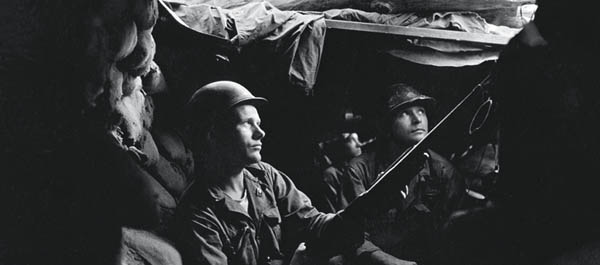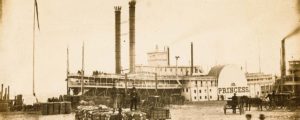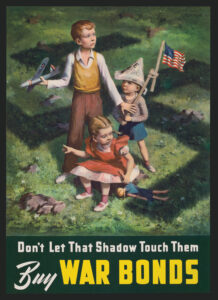THE SLANG OF “THE FORGOTTEN WAR” as the Korean conflict from 1950 to 1953 is often called, has not been forgotten. Much of it originated in World War II, because many of the American troops in Korea were World War II veterans.
One such term was to bug out, or simply to bug, meaning to run away and hence play the coward. Its origin is unknown, but it may have come from the sense of being obsessed or desperate. The term was first employed during World War II, but it did not gain wide usage until the Korean War.
It had multiple but related meanings. In noun form, often hyphenated (bug-out), it denoted a hasty retreat, an escape route, and the person beating such a retreat. A 1951 New York Herald Tribune article had: “Men talked of ‘bug-out gas’ and ‘bug-out jeeps’ and ‘bug-out routes’.” The military film D.I. (1957) used it denoting a person: “We’ve got a bug-out, Owen.”
The term gained further currency with “I’m Movin’ On,” a popular song of 1950 by Hank Snow that aired on the Armed Services Radio Network. Some soldier—it is not remembered who—changed the words to commemorate a major U.S. retreat.
It was supposedly first sung by black soldiers of the 24th Infantry Regiment, and one line went, “When them Chinese mortars begin to thud, the old Deuce-Four begin to bug.” There were numerous other versions of the song, but many had the refrain, “We’re buggin’ out, We’re movin’ on.” It was renamed “Bugout Boogie” and officially forbidden but nevertheless became the unofficial anthem of the Korean conflict. From it also came the expression to pull a Hank Snow, meaning to bug out. In time, bug out entered the civilian vocabulary with the similar meaning of quitting or abandoning some enterprise.
The term sweat it out apparently originated as long ago as 1865 but rarely appeared in print until World War II. It meant to wait anxiously, as in sweating out the delay in getting expected orders. It was used in the Korean War in several forms, including no sweat, meaning something easy, no trouble at all. According to one authority, Korean women would say, “No sweat, GI. MPs no come,” to let a soldier know it would be safe for him to dally with her. The negative form particularly entered civilian vernacular, as in “I’ll get it done in time—no sweat.”
Two terms describing reactions to Korea’s combat were to go mental and to be shook. Denoting nerve crises, they largely replaced shell shock of World War I and combat fatigue of World War II.
After Pearl Harbor, Pacific Fleet commander Admiral Chester Nimitz noted the importance of logistics and supplies in World War II: “Winning the war is a matter of beans, bullets, and oil.” By the Korean War, bullets and beans was used to describe all military materiel, including weapons, munitions, equipment, and supplies. It appeared on November 19, 1950, in a Washington Post article about the Korea airlift: “The commander said the airlift carried more than 63,000 tons of bullets and beans and 100,000 passengers.” It was later varied: bombs, bullets, and beans; bullets, beans, and black oil; and so on.
The term spider hole began life in World War II, resurfaced in Korea, and gained currency in Vietnam. Alluding to the camouflaged hole constructed by the trapdoor spider, it denoted a shoulder-deep protective hole with a covering and used both for ambush by a sniper and as a protected hiding place. According to one infantry commander in the Battle of Leyte, “Some spider holes contained primitive land minds [sic] that the Japanese apparently were supposed to detonate if a tank or other vehicle rolled over them. This was a suicide mission for the soldiers in the spider holes.” In About Face: The Odyssey of an American Warrior, David H. Hackworth described the use of coordinated spider holes in Korea: “The Chinese had dug a virtual siege line only a couple of hundred yards from K Company. Their manned spider holes made it impossible for anyone to stick his head up during the day without drawing a sniper shot.”
The Korean War was the first in which manned jet fighters engaged one another. After World War II, the Soviet Union provided a number of its warplanes, most prominently the Yakovlev Yak-9 fighter, to satellite states and North Korea. The Yak and another Soviet-made plane, the MiG-15 jet fighter, became the principal air targets for NATO troops. The Americans claim to have shot down 11 MiGs for every one of their F-86 Sabre jets lost, thanks to effective radar and superior flying skills. Consequently the war came up with the term triple jet ace, for a jet fighter pilot who shot down 15 or more aircraft in one day. Among the American pilots in Korea, James Jabara achieved that number, followed by Manuel Fernandez with 15 ½. On May 18, 1953, his last day of combat flying, Captain Joseph McConnell shot down three MiGs in two separate missions, making him the American ace of aces over Korea, with a total of 16.
Christine Ammer has written dozens of wordbooks, including Facts on File Dictionary of Clichés, 3rd edition.






